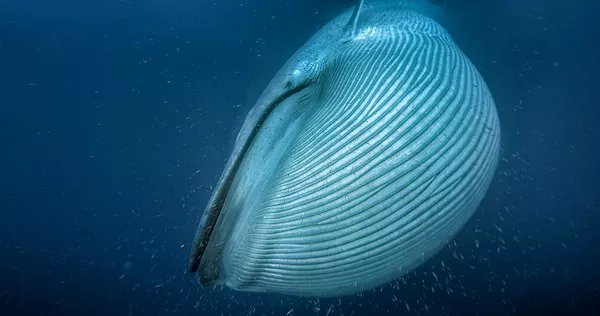In the vast expanses of the world’s oceans, the blue whale stands as an emblem of majestic enormity, capturing the imagination of humanity with its sheer size and grace. Among these giants, there exists a select few that command awe and fascination on an unprecedented scale. In this article, we embark on a journey to explore the remarkable story behind the largest blue whale ever recorded, delving into its significance, the scientific insights it offers, and the conservation implications it holds.
Unveiling the Enigma:
At the heart of our exploration lies the colossal blue whale, the largest animal known to have ever graced our planet. The blue whale (Balaenoptera musculus) holds a special place in the annals of natural history, with its astounding dimensions dwarfing even the most imposing creatures of the land. Averaging between 70 to 90 feet in length and weighing in at a staggering 100 to 200 tons, these marine leviathans are the epitome of oceanic grandeur.
Yet, within this realm of giants, there exists an individual that surpasses all expectations—the largest blue whale ever documented. This monumental specimen, a true titan of the deep, offers a glimpse into the extraordinary capabilities of nature and the mysteries that lie beneath the waves.
Discovery and Documentation:
The discovery of the largest blue whale on record is a testament to the dedication and perseverance of marine biologists and researchers. Spanning decades of observation and study, the quest to unravel the secrets of these marine behemoths has led to remarkable revelations.
In 1909, a momentous event unfolded off the coast of South Georgia—an island in the southern Atlantic Ocean. A blue whale measuring an astonishing 110 feet in length was captured, setting a precedent in the annals of marine biology. This monumental specimen, dubbed the “South Georgia giant,” became the focal point of scientific inquiry, sparking a global fascination with the unparalleled dimensions of the blue whale species.
Subsequent expeditions and advancements in technology have further expanded our understanding of these magnificent creatures. Through the use of acoustic monitoring, satellite tagging, and photographic identification, researchers have been able to track the movements and behaviors of individual blue whales with unprecedented precision.
The Magnitude of the Giant:
To comprehend the sheer magnitude of the largest blue whale ever recorded, one must delve into the intricacies of its anatomy and physiology. From its colossal frame to its remarkable feeding habits, every aspect of this marine marvel serves as a testament to the evolutionary triumph of size and efficiency.
At the heart of the blue whale’s prowess lies its immense size. With a length exceeding that of a commercial airliner and a weight comparable to dozens of elephants, this leviathan of the deep reigns supreme as the undisputed heavyweight champion of the animal kingdom. Yet, despite its gargantuan proportions, the blue whale possesses a grace and agility that belies its immense bulk, effortlessly gliding through the ocean depths with unparalleled elegance.
Central to the blue whale’s existence is its remarkable feeding strategy. As filter feeders, these cetaceans rely on a specialized structure known as baleen to strain vast quantities of water for tiny organisms such as krill—a shrimp-like crustacean that forms the cornerstone of their diet. With mouths capable of engulfing volumes of water equivalent to their own body mass, blue whales possess an insatiable appetite that drives them to consume several tons of krill each day.
The Significance of the Giant:
Beyond its sheer size and physical prowess, the largest blue whale ever recorded holds profound significance for both science and society. From its role as a flagship species for marine conservation to its contributions to our understanding of ecological dynamics, this monumental specimen serves as a symbol of the interconnectedness of life in the oceans.
As a flagship species, the blue whale plays a crucial role in raising awareness about the importance of marine conservation. By captivating the public’s imagination with its awe-inspiring presence, this iconic creature serves as a rallying point for efforts to protect the fragile ecosystems upon which it depends. From initiatives aimed at reducing marine pollution to measures designed to mitigate the impacts of climate change, the conservation of blue whales serves as a litmus test for our commitment to preserving the diversity and beauty of the world’s oceans.
Furthermore, the study of the largest blue whale offers valuable insights into the ecological dynamics of marine ecosystems. By tracking the movements and behaviors of these magnificent creatures, researchers can gain a deeper understanding of the complex interactions that shape life in the oceans. From the cascading effects of prey availability on blue whale populations to the role of migratory corridors in maintaining genetic diversity, the study of these giants provides a window into the inner workings of marine ecosystems on a global scale.
Conservation Implications:
The conservation of the largest blue whale ever recorded carries profound implications for the future of our planet’s oceans. As stewards of the natural world, it is incumbent upon us to safeguard the habitats and ecosystems upon which these magnificent creatures depend. From the implementation of marine protected areas to the enforcement of regulations aimed at reducing human impacts on the marine environment, concerted efforts are needed to ensure the continued survival of blue whales and the myriad other species that call the oceans home.
Moreover, the conservation of blue whales is inextricably linked to broader efforts to address the myriad threats facing marine ecosystems. From climate change and ocean acidification to overfishing and habitat destruction, the challenges confronting our oceans are vast and complex. Yet, by working together to implement science-based solutions and promote sustainable practices, we can create a future in which blue whales—and all marine life—thrive in healthy and vibrant ecosystems.
See Also: The World’s Largest Cephalopod – The Giant Squid!
Conclusion:
In the vast expanse of the world’s oceans, the largest blue whale ever recorded stands as a testament to the awe-inspiring diversity and grandeur of marine life. From its monumental dimensions to its profound significance for science and society, this monumental specimen serves as a beacon of hope and inspiration for future generations. As we continue to explore the mysteries of the deep and strive to protect the fragile ecosystems upon which blue whales depend, let us remember the importance of preserving the wonders of our oceans for generations to come.
You Might Be Interested In:
- The Tallest Animal In The World – Giraffes!
- Animals in the World – You May Not Know” href=”https://www.validdownloads.com/archives/2541″ rel=”bookmark”>20 Cutest Animals In The World – You May Not Know
- 8 Animals With Unusual Behaviors












![10 Most Richest Cities in the United States [Revealed!]](https://www.validdownloads.com/wp-content/uploads/2023/12/Bengal-Tiger.webp)













